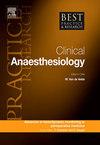硬脊膜穿刺后头痛:证据不足
IF 2.8
3区 医学
Q1 ANESTHESIOLOGY
Best Practice & Research-Clinical Anaesthesiology
Pub Date : 2024-09-01
DOI:10.1016/j.bpa.2024.11.004
引用次数: 0
摘要
尽管手术技术和设备有所进步,硬脊膜穿刺后头痛(PDPH)仍然是意外硬脊膜穿刺(ADP)后分娩硬脊膜外镇痛的严重并发症。PDPH通常被认为是暂时的不便,在短期内会使人虚弱。它也可能与慢性表现和严重并发症有关。PDPH的确切潜在机制尚不完全清楚,长期以来关于脑脊液(CSF)稳态失调由于CSF液丢失的观点目前正在受到挑战。与脑脊液丧失无关的直立性头痛的存在需要考虑其他相关机制,例如,与自主神经系统或与脑膜和脑动脉激活相关的降钙素基因相关肽(CGRP)的释放有关。一个多社会国际工作组最近提供了关于预防、诊断和管理由轴突手术引起的PDPH的循证建议。根据建议,没有足够的证据支持常规使用鞘内导管或蝶腭神经节阻滞来预防或治疗PDPH。基于证据和实验的策略包括通过防止脑脊液损失、补充脑脊液或增加脑脊液产量和减少脑血管舒张来稳定脑脊液动力学。通过标准化的定义、干预措施和结果测量,可以促进PDPH预防和治疗策略的未来研究。分析应考虑各种混杂因素,并认识到不同人群中疼痛经历的复杂多因素性质。PDPH的临床护理和研究需要多学科的合作,以阐明其病理生理学的复杂性,并进一步改善患者的预后和护理质量。本文章由计算机程序翻译,如有差异,请以英文原文为准。
Postdural puncture headache: Beyond the evidence
Despite advances in procedural techniques and equipment, postdural puncture headache (PDPH) remains a serious complication of labour epidural analgesia after accidental dural puncture (ADP). Often considered a temporary inconvenience, PDPH can be debilitating in the short term. It can also be associated with chronic manifestations and serious complications.
The precise underlying mechanisms of PDPH are still incompletely understood, and longstanding beliefs of dysregulation of cerebrospinal fluid (CSF) homeostasis due to CSF fluid loss are currently being challenged. The existence of orthostatic headaches unrelated to CSF loss demands consideration of other mechanisms involved, for instance, related to the autonomic nervous system or the release of calcitonin gene-related peptide (CGRP) associated with activation of the meningeal and cerebral arteries.
A multi-society international working group recently provided evidence-based recommendations on the prevention, diagnosis, and management of PDPH resulting from neuraxial procedures. According to the recommendations, there was insufficient evidence to support the routine use of intrathecal catheters or sphenopalatine ganglion blocks to prevent or treat PDPH. Both evidence-based and experimental strategies include stabilizing CSF dynamics through preventing CSF loss, supplementing CSF, or increasing production, and reducing cerebral vasodilation.
Future research in PDPH preventive and therapeutic strategies can be facilitated with standardised definitions, interventions, and outcome measures. Analyses should consider various confounding factors and recognise the complex multifactorial nature of pain experience across diverse populations. Clinical care and research on PDPH will demand a multidisciplinary collaborative effort to elucidate the complexities of its pathophysiology and further improve patient outcome and quality of care.
求助全文
通过发布文献求助,成功后即可免费获取论文全文。
去求助
来源期刊

Best Practice & Research-Clinical Anaesthesiology
ANESTHESIOLOGY-
自引率
0.00%
发文量
37
审稿时长
36 days
 求助内容:
求助内容: 应助结果提醒方式:
应助结果提醒方式:


